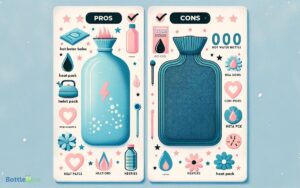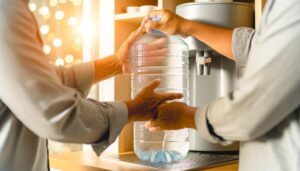Can You Put Coffee in a Plastic Water Bottle? Explored!
You shouldn’t put coffee in a plastic water bottle. Heat can cause chemicals like BPA and phthalates to leach into your drink, which poses health risks.
The acidity of coffee can accelerate this process. Coffee can also alter the taste due to interactions with plastic, possibly giving it a plastic-like flavor.
Additionally, plastic bottles aren’t well-insulated, so your coffee will cool quickly. Instead, use stainless steel or glass containers to maintain taste and avoid harmful chemicals. If you want to learn about alternative options and best practices, there’s more to explore.

Key Takeaways
Safety Concerns
When considering putting coffee in a plastic water bottle, you need to be aware of several safety concerns that could impact your health.
First, many plastic bottles contain chemicals like BPA or phthalates, which can leach into your drink, especially when exposed to high temperatures.
Hot liquids can accelerate this process, increasing your exposure to these potentially harmful substances.
Additionally, plastic bottles mightn’t be designed to withstand the heat of coffee, leading to structural degradation. This can result in the release of microplastics into your beverage.
To mitigate these risks, it’s important to check if the plastic bottle is labeled as BPA-free and designed for hot liquids. Always prioritize containers specifically made for hot beverages.
Effects on Taste
Placing coffee in a plastic water bottle can noticeably alter its taste, often imparting a plastic-like flavor to your drink.
The chemicals in plastic can leach into the coffee, especially if the plastic isn’t designed to withstand acidic or hot liquids.
This leaching process can result in an unpleasant taste and compromise the quality of your coffee.
Additionally, the oils in coffee can interact with the plastic, further affecting the flavor profile. To avoid these issues, it’s important to use containers specifically made for hot beverages.
Stainless steel or glass bottles are better alternatives as they don’t interact with the coffee, preserving its intended taste.
Temperature Considerations
When considering putting coffee in a plastic water bottle, you need to think about the plastic’s melting point.
Most plastic bottles aren’t designed to handle high temperatures and could warp or release harmful chemicals.
Additionally, plastic has poor insulation, meaning it won’t retain heat well, causing your coffee to cool quickly.
Plastic Melting Point
Most plastic water bottles are made from materials like PET or HDPE, which have specific melting points that you’ll need to take into account before putting hot coffee in them. Exposing these plastics to high temperatures can cause them to deform or even release harmful chemicals into your drink. If you’re wondering, can you put hot tea in a plastic bottle, the answer depends on the type of plastic and its heat resistance. To be safe, it’s best to use a container specifically designed for hot liquids, such as a stainless steel or glass thermos.
PET has a melting point of around 250°C (482°F), while HDPE melts at approximately 130°C (266°F).
However, these materials can start deforming at much lower temperatures, potentially releasing harmful chemicals.
Consider these factors:
- Temperature of Coffee: Coffee is typically brewed at 90-96°C (194-205°F), which can stress plastic polymers.
- Plastic Deformation: Even if the plastic doesn’t melt, it might deform and lose structural integrity around 60-70°C (140-158°F).
- Chemical Leaching: Higher temperatures can increase the risk of chemicals like BPA leaching into your drink.
Use these points to make an informed decision.
Insulation and Heat Retention
Considering insulation and heat retention, you should be aware that plastic water bottles generally lack the ability to maintain coffee’s ideal temperature.
Plastic is a poor insulator compared to materials like stainless steel or glass. When you pour hot coffee into a plastic bottle, the heat quickly dissipates, causing your coffee to cool down faster than you’d like.
Additionally, the bottle’s exterior can become uncomfortably warm to the touch, posing a risk of burns. If you prefer your coffee hot for an extended period, it’s better to use an insulated travel mug designed to retain heat.
Conversely, if you plan to drink your coffee quickly, a plastic bottle might suffice, but it won’t offer the best thermal performance.
Chemical Leaching
When you put hot coffee in a plastic water bottle, the heat can cause chemicals like BPA and phthalates to leach into your drink.
This interaction between heat and plastic poses potential health risks, including endocrine disruption and increased cancer risk.
Understanding these risks is crucial before deciding to use plastic bottles for hot beverages.
Heat and Plastic Interaction
Heating plastic water bottles can cause harmful chemicals to leach into your coffee. When you expose plastic to high temperatures, certain chemicals can migrate into the liquid.
Here’s what you should know:
- BPA: Bisphenol A, often found in polycarbonate plastics, can seep into your drink when heated.
- Phthalates: Used to make plastics flexible, these can also leach out under heat, potentially contaminating your coffee.
- Styrene: Found in some disposable plastic bottles, this chemical can break down and mix with your coffee at high temperatures.
Understanding these interactions is crucial for your safety. Always check the type of plastic and its heat tolerance before using it for hot beverages. This can help you avoid unwanted chemical exposure.
Health Risks Involved
Ever wonder what health risks you might face from the chemicals leaching into your coffee from a plastic water bottle?
When you pour hot coffee into a plastic bottle, heat can cause harmful chemicals like BPA and phthalates to leach into your drink. BPA, or bisphenol A, is linked to endocrine disruption, which can affect hormone balance.
Phthalates may impact reproductive health and have been associated with developmental issues in children.
Even plastics labeled as BPA-free aren’t entirely safe, as they may contain other harmful chemicals.
Continuous exposure to these substances can accumulate in your body over time, potentially leading to long-term health issues.
Using glass or stainless steel containers is a safer option for your hot beverages.
Types of Plastics
Understanding the different types of plastics is crucial when considering whether it’s safe to put coffee in a plastic water bottle.
Plastics vary in their chemical composition, which affects their heat resistance and potential for leaching harmful substances.
Here are three common types:
- PET (Polyethylene Terephthalate): Often used for single-use bottles, PET can handle cold liquids but isn’t designed for hot liquids like coffee.
- HDPE (High-Density Polyethylene): This plastic is more durable and can withstand higher temperatures, but it’s typically opaque and used for items like milk jugs.
- PP (Polypropylene): Known for its high heat tolerance, PP is often used in food containers and is generally safe for hot beverages.
Choose the right plastic to guarantee safety and durability.
Health Implications
Putting coffee in a plastic water bottle can raise significant health concerns due to the potential for harmful chemicals to leach into your drink.
When exposed to heat, certain plastics can release chemicals like Bisphenol A (BPA) and phthalates.
These substances can disrupt your endocrine system, potentially leading to hormonal imbalances and other health issues.
Even plastics labeled as ‘BPA-free‘ might still contain other harmful compounds that aren’t fully understood yet.
Additionally, the acidity of coffee can further accelerate the leaching process, increasing your exposure to these chemicals.
To minimize health risks, it’s advisable to use containers made from materials like stainless steel or glass, which are more resistant to heat and don’t leach harmful substances.
Environmental Impact
Beyond health concerns, using plastic water bottles for coffee also has a significant environmental impact. When you choose plastic, you contribute to several ecological issues.
- Increased waste: Single-use plastics often end up in landfills or oceans, causing long-term pollution.
- Resource depletion: Producing plastic bottles requires petroleum and other non-renewable resources, which are finite and contribute to environmental degradation.
- Energy consumption: Manufacturing and recycling plastic bottles consume large amounts of energy, increasing greenhouse gas emissions and contributing to climate change.
Alternative Containers
Consider switching to alternative containers like stainless steel or glass, which are more sustainable and safer for your health.
Stainless steel and glass don’t leach harmful chemicals into your coffee and maintain the beverage’s taste and temperature better than plastic. They are also more durable and environmentally friendly.
Here’s a quick comparison:
| Container Type | Durability | Health Impact |
|---|---|---|
| Plastic | Low | Potentially harmful |
| Stainless Steel | High | Safe |
| Glass | Moderate | Safe |
Best Practices
Always verify that your coffee is at a safe temperature before pouring it into any container to prevent burns and preserve flavor.
When using a plastic water bottle, follow these best practices:
- Check Material Safety: Confirm the plastic is BPA-free and designed to withstand hot liquids. Look for labels indicating it’s safe for hot beverages.
- Preheat the Bottle: Pour a small amount of hot water into the bottle first to acclimate the plastic, then empty it before adding coffee. This reduces the risk of cracking or warping.
- Use a Lid with a Vent: If your bottle has a lid, make sure it has a vent to release steam. This helps prevent pressure build-up that could cause leaks or spills.
Adhering to these guidelines will help you safely enjoy your coffee.
Conclusion
Coffee in a plastic water bottle raises significant safety concerns and can compromise taste. Temperature variations may trigger chemical leaching, leading to potential health hazards.
Different types of plastics offer varying degrees of safety, but it’s essential to consider environmental impacts too. Alternatives like stainless steel or glass are safer and more sustainable.
Stick to smart, safe practices, and select suitable containers to ensure your coffee consumption is both delightful and dependable.





